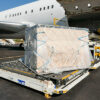FAQ #1: What is Air Freight Forwarding?
If you have been browsing the internet for any length of time, (really, who hasn’t?) you are likely very aware of the FAQ section that is available on every single website. While you are most likely aware, how often do you take the time to actually READ the FAQs? Admittedly, most of us never read that section. This being the case, here at Alaska Air Forwarding, we thought it would be a GREAT idea to do a blog series on our FAQs.
FREQUENTLY ASKED QUESTION #1
If you’ve ever visited our FAQ page, (we encourage you to do so) you will find that the very first question is: What is Air Freight Forwarding?
Here at Alaska Air Forwarding, Air freight forwarding is our specialty; it’s what we’ve been doing for over 50 years. However, to properly answer the question “what is it” we thought it would be helpful to delve a little deeper into the topic of Air Freight Forwarding.
When it comes to shipping, you really can ship pretty much anything by air. At Alaska Air Forwarding, we have always adhered to that philosophy, which is why we have been so successful over the years. Airplanes are amazing machines that offer huge capacity for shipping huge freight.
Freight can be shipped one of three ways:
- Freight can be shipped on passenger planes
- Freight can be shipped on dedicated freight cargo planes
- Huge, payload freight can be shipped on super transporters
Passenger Planes
Believe it or not, when you board a plane to fly off for vacation or a business trip, a significant portion of the cargo being transported is freight. Most commercial airlines make a small percentage (5-10%) of their revenue by shipping non-passenger freight. In fact, the US Post Office leases space on approximately 15,000 of the 25,000 commercial passenger flights that leave daily throughout the country. The freight is typically consolidated on commercial flights but here is an interesting piece of information, a Boeing 747-400 can hold 416 passengers and 5,330 cubic feet of cargo, which is enough to fit into two semi-truck trailers.
Cargo Planes
Cargo planes are planes that strictly ship freight. Larger freight companies such as FedEx and UPS own many different types of cargo planes. The Boeing 747-400 can also be configured as a cargo plane and is one of the largest available holding 26,000 cubic feet of cargo which is the equivalent of five semi-trucks. Cargo planes can ship almost any kind of freight, including irregularly shaped freight because the nose of the plane is designed to be opened to accommodate this type of freight. Cargo planes can even ship animals! Large animals, such as horses, are placed in airstables that connect to pallets in the cargo hold area.
Super Transporters
The third way to ship freight is via a Super Transporter. These are a class of planes that are designed to move extremely large cargo such as helicopters and even other airplanes. These super transport planes are designed with a cargo area that is situated above the cockpit and spans the entire length of the airplane. The door of the plane is designed to open completely to fit large cargo onto the plane. If the cargo can fit onto the plane, it can fit through the door.
This is the reason that our FAQ page states: “This means we ship heavy lift cargo to and from Alaska via air transportation.” The fact that we have access to these and many other shipping resources is the reason that we have been able to successfully serve Alaska for more than 50 years. Now you have an even better understanding of what air freight shipping really is, so the next time you board a plane, you’ll know that not only are you traveling, you’re also likely helping air freight get to its destination as well.






